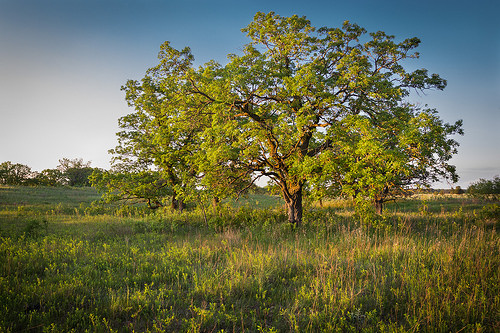There are many types of oak trees: northern pin oak, bur oak, northern red oak…the list goes on and on. But with so many native oak species, how do we Minnesotans tell them apart? Before you can identify these different oak trees, you need to know what you’re looking for. Learn about the identifying characteristics of different oak trees below.
Northern Pin Oak
Northern pin oak trees are commonly found in the southeastern part of Minnesota, though overall they aren’t abundant in our state. These trees grow to up to 65 feet and have a narrow, open crown caused by drooping branches. The bark is gray to dark brown in color and the tree grows reddish brown acorns. The leaves grow to a length of up to 6 inches and typically have seven lobes with bristles. The leaves turn bright red in the fall.
Bur Oak
Bur oak trees are very common throughout Minnesota. These trees grow to a height of roughly 80 feet under the best conditions but only grow to a height of about 15 feet if grown under poor conditions. The body is short with a large, wide crown. The bark is gray and these trees grow deeply set acorns (think oversized hats). The leaves grow to a length of up to 12 inches and have a unique shape, as they are thinner toward the stem and widen at the end of the leaf with several notches around the edge. The leaves turn brown or yellow in fall. While living in Minnesota, you may have heard of bur oak blight. Read about it here.
Northern Red Oak
Northern red oak trees grow throughout Minnesota. These trees grow to a height of up to 80 feet and have long, narrow crowns. The bark of the northern red oak has dark brown to dark gray coloring. Large acorns that are green to brown grow on the stems of the northern red oak. The leaves grow up to 9 inches in length with roughly nine lobes that have jagged edges. The leaves turn bright red in the fall. If northern red oak is a tree on your landscape, be sure to watch for oak wilt fungus, a common leaf disease.
Chestnut Oak
Chestnut oak trees are commonly found in the southeastern part of Minnesota and grow to a height of up to 100 feet. The size and shape of the crown depends on the space allowed for the tree’s growth. Those grown in the forest have narrow crowns while those grown in open areas have wide, rounded crowns. The bark of the chestnut oak is light gray and chips off of older trunks. Small, brown acorns grow on the stems of chestnut oak trees. The leaves grow up to 7 inches long and are mostly oval shape with jagged teeth along the edges. They turn red to burnt orange in the fall. While there is a tree pest named two-lined chestnut borer, its preferred host is the red oak. We do recommend always being aware of pests, however, even if they prefer a different host.
White Oak
White oak trees are found in southeastern Minnesota, as far up as the Minneapolis-St. Paul area and are not found in the northern or western parts of the state. These trees grow to a height of up to 80 feet and the size and shape of the crown depends on the space allowed, just like the chestnut oak. White oak trees are often found with rounded crowns that have oddly spaced branches. The bark is light gray and the tree grows small, brown acorns. The leaves grow up to 9 inches long and the edges are separated into numerous lobes. They turn brown or red in the fall.
As you can tell, there are plenty of identifying characteristics for different types of oak trees. However, it’s not always as easy to identify the presence of pests or diseases. Check out our “Tree Care” blog category on the right hand side of the page to learn more about different tree pests and diseases. You can also call us at 651-653-9930 with any questions or concerns.
Photo courtesy of Justin Meissen | https://www.flickr.com/photos/40855483@N00/







